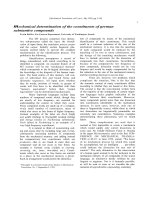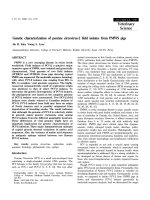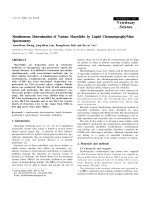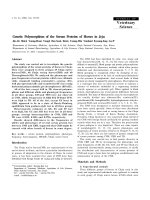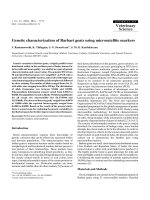Báo cáo khoa học: "Genetic determination of vessel area in oak (Quercus robur L and Q petraea Liebl): a characteristic related to the occurrence of stem shakes" docx
Bạn đang xem bản rút gọn của tài liệu. Xem và tải ngay bản đầy đủ của tài liệu tại đây (212.12 KB, 4 trang )
Original
article
Genetic
determination
of
vessel
area
in
oak
(Quercus
robur
L and
Q
petraea
Liebl):
a
characteristic
related
to
the
occurrence
of
stem
shakes
RA
Mather,
PJ
Kanowski,
PS
Savill
Oxford
Forestry
Institute,
Department
of
Plant
Sciences,
University
of
Oxford,
South
Parks
Road,
Oxford
OX1
3R8,
UK
Summary —
The
term
"shake"
describes
the
presence
of
longitudinal
separations
in
the
wood
of
liv-
ing
trees.
Predisposition
to
shake
in
Quercus
robur and
Q petraea
increases
with
the
cross-sectional
areas
of
earlywood
vessels.
Investigations
suggest
that
vessel
area
is
under
strong
genetic
control,
and
is
related
to
provenance
and
to
the
timing
of leaf
emergence
in
the
spring.
These
results
are
promising
for
those
concerned
with
selecting
oak
varieties
less
prone
to
shake
or
wishing
to
recog-
nize
and
remove
shake-prone
trees
early
in
rotations.
heritability
/
Quercus
/ shake
/
wood
quality
/
phenology
Résumé—
Déterminisme
génétique
du
diamètre
des
vaisseaux
du
bois
chez
le
chêne
(Quercus
robur
et
Q
petraea
Liebl) :
une
caractéristique
liée
à
la
sensibilité
aux
fentes
internes
du
tronc.
Le
terme
de
«fente»
désigne
la
présence
de
séparations
longitudinales
dans
le
bois
des
arbres
vi-
vants.
La
prédisposition
aux
fentes
chez
Quercus
robur
et
Q
petraea
augmente
avec
la
surface
de
la
section
transversale
des
vaisseaux
du
bois
initial.
Des
recherches
suggèrent
que
la
surface
des
vais-
seaux
est
soumise
à
un
contrôle
génétique
fort
(niveau
intraspécifique
et
niveau
génétique
individuel),
ainsi
qu’à
la
période
d’apparition
des
feuilles
au
printemps.
Ces
résultats
sont
prometteurs
pour
ceux
qui
s’intéressent
à
la
sélection
des
variétés
de
chêne
peu
sensibles
aux
fentes
du
tronc
ou
qui
souhai-
tent
repérer
et
éliminer
précocement
les
arbres
sensibles
aux
fentes
lors
d’éclaircies.
héritabilité / Quercus
/ fente
du
tronc / qualité
du
bois / phénologie
INTRODUCTION
The
timber
defect
known
as
shake
is
des-
cribed
by
Panshin
and
de
Zeeuw
(1980)
as
"
longitudinal
separations
of
the
wood
which
appear
in
the
standing
tree".
Ring
porous
oaks
are
frequently
affected
by
shake.
Savill
(1986)
found
that
the
mean
cross-sectional
area
of
the
large
earlywood
vessels
was
significantly
grea-
ter
in
shaken
trees
than
in
sound
ones.
Additionally,
Cinotti
(1991)
has
shown
that
the
incidence
of
frost-cracking
in
oak,
a
condition
that
is
similar
to
shake,
also
in-
creases
with
vessel
size.
With
the
informa-
tion
that
large
vessels
predispose
oaks
to
shake,
our
objectives
were
to:
1)
determine
provenance
variations
in
vessel
size;
2)
es-
timate
the
heritability
of
vessel
size;
and
3)
to
find
a
means
of
recognizing
shake-prone
trees
so
that
they
could
be
removed
during
early
thinning
operations.
Some
of
these
aspects
have
been
discussed
further
by
Savill
and
Mather
(1990).
MATERIALS
AND
METHODS
In
each
case,
5
mm
increment
cores
were
taken
at
1.3 m.
The
principal
provenance
trial,
established
by
Krahl-Urban
in
1950,
was
located
in
the
Bramwald
Forest.
In
1951,
the
trial
was
replica-
ted
at
Syke
near
Bremen,
using
seedling
trans-
plants
from
the
Bramwald
site.
The
sample
ob-
jective
for
each
site
was
12
trees
per
provenance,
5
provenances
per
species
(Q
robur
and
Q
petraea).
The
sample
obtained
fell
short
of
the
objective
by
32
trees
due
to
fewer
surviving
trees
at
Syke.
Heritability
studies
used
material
collected
from
a
half-sib
progeny
trial,
also
located
in
Bramwald
Forest
near
Kassel
in
Lower
Saxony,
Germany.
The
experiment,
established
in
1950,
consisted
of
32
half-sib
families
of
Q
robur
plan-
ted
in
an
unreplicated
design.
Investigations
into
the
association
between
the
progress
of
flushing
and
vessel
size
were
undertaken
on
20
early
and
20
late
flushing
trees
to
indigenous
Q
petraea
stored
coppice
at
Bagley
Wood,
Oxford.
Tree
mean
vessel
areas,
expressed
in
μm
2,
were
determined
from
radial
measurements
of
vessels
from
5
mm
wood
cores,
using
a
travel-
ling
microscope
equipped
with
an
electronic
digi-
tizer
that
was
accurate
to
±
2
μm.
RESULTS
AND
DISCUSSION
Provenance
study
The
analysis
of
variance
for
the
prove-
nance
trial
data
is
presented
in
table
I,
from
which
it
can
be
seen
that
the
factors
significantly
influencing
vessel
size
are
the
width
of
annual
rings
and
provenances.
There
is
also
an
interaction
of
provenance
with
sites
which
reinforces
Kleinschmit’s
(1986)
point
that
selection
of
desirable
pro-
venances
should
be
specific
to
particular
sites.
Heritability
study
The
model
fitted
to
vessel
area
data
may
be
expressed
as:
where
VAij
is
the
observation
on
individual
j
of
genotype
or
family
i,
μ
is
the
overall
mean
vessel
area; g
i
is
the
effect
of
geno-
type
i,
considered
as
random;
e
ij
is
the
nor-
mally
and
independently
distributed
ran-
dom
deviation
of
genotype
i,
with
a
mean
of
zero.
Differences
between
families
were
highly
significant
(P
<
0.001).
Variance
components
were
estimated
by
analysis
of
variance
and
narrow
sense
heritability
esti-
mated
from
variance
components
accor-
ding
to
the
expression:
where
σ
2e
and
σ
2g
are
the
components
due
to
within-family
and
between
family
varia-
tion.
Acknowledging
the
limitations
of
unre-
plicated
trials,
estimated
values,
respec-
tively
at
0.60
±
0.25
on
an
individual
tree
basis
and
0.79
±
0.21
on
a
family
mean
basis
(see
table
II),
indicate
that
vessel
area
is
under
strong
additive
genetic
control.
This
is
consistent
with
results
re-
ported
for
wood
characteristics
in
many
species
(Burley,
1982;
Zobel
and
van
Buij-
tenen,
1989),
as
well
as
from
similar
mate-
rial
in
oaks
(Nepveu,
1984).
These
results
are
discussed
in
more
detail
by
Kanowski
et al (1991).
Relationship
between
flushing
dates
and
vessel
sizes
The
analysis
of
variance,
summarized
in
table
III,
shows
highly
significant
diffe-
rences
between
early
and
late
flushing
trees
(P
>
0.0001)
which
accounted
for
al-
most
20%
of
all
variation.
Means
and
stan-
dard
errors
for
vessel
areas
for
early
and
late
flushing
trees
were
67
134
±
3
090
μm
2
and
83
754 ±
2 854
μm
2,
respectively.
Results
showed
clearly
that
early-
flushing
trees
tend
to
have
vessels
of
smaller
cross-sectional
areas
than
late
flushing
ones.
In
oak,
new
vessels
are
formed
about
1
week
after
buds
break.
In-
dole-3-acetic
acid
(IAA)
is
believed
to
pro-
vide
the
stimulus
for
vessel
growth
(Long-
man
and
Coutts,
1974),
and
has
been
shown
to
produce
earlywood
vessels
with
larger
lumen
areas
in
ash
(Doley
and
Ley-
ton,
1968).
The
fact
that
IAA
is
also
known
to
inhibit
the
emergence
of
buds
in
Q
alba
(Vogt
and
Cox,
1970)
strongly
suggests
that
leaf
emergence
and
earlywood
forma-
tion
are
inextricably
linked
through
a
com-
mon
association
with
IAA.
CONCLUSIONS
Results
from
progeny
and
provenance
trials
suggest
that
selection
and
breeding
at
the
level
of
provenances
and
individuals
should
both
be
effective
in
reducing
the
frequency
of
shake
in
oaks.
Meanwhile,
the
tendency
of
trees
with
large
earlywood
vessels
to
flush
latest
provides
a
useful
means
for
the
early
recognition
and
remo-
val
of
shake-prone
individuals.
It
should,
ho-
wever,
be
understood
that
selections
made
on
vessel
size
may
have
other
undetermi-
ned
physiological
consequences
and
also
influence
wood
technical
properties.
ACKNOWLEDGMENTS
We
thank
Dr
Jochen
Kleinschmit
of
the
Nieder-
sächsische
Forstliche
Versuchsanstalt,
Esche-
rode,
for
advice
and
access
to
progeny
and
pro-
venance
trials.
We
are
also
indebted
to
Dr
Gérard
Nepveu
of
Centre
de
Recherches
Fores-
tières
de
Nancy
(INRA),
for
help
on
numerous
occasions.
The
work
was
funded
by
the
Com-
mission
of
the
European
Communities
under
the
project
title
«Genetics
and
breeding
of
oaks»
(MA
1B/009-0016,
0037-0038),
and
also
supported
by
the
Scottish
Forestry
Trust.
REFERENCES
Burley
J
(1982)
Genetic
variations
in
wood
pro-
perties.
In:
New
Perspectives
in
Wood
Anato-
my
(Baas
P,
ed),
Martinus
Nijhoff,
The
Hague,
151-169
Cinotti
B
(1991)
Recherche
de
propriétés
intrin-
sèques
du
bois
pouvant
expliquer
la
sensibili-
té
à
la
gélivure
de
Quercus
petraea
(Liebl)
et
Q
robur (L).
Ann
Sci
For
48,
453-468
Doley
D,
Leyton
L
(1968)
Effects
of
growth
regu-
lating
substances
and
water
potential
on
the
development
of
secondary
xylem
in
Fraxinus.
New
Phytol 67,
579-594
Kanowski
PJ,
Mather
RA,
Savill
PS
(1991)
Ge-
netic
control
of
oak
shake;
some
preliminary
results.
Silvae
Genet
40,
166-168
Kleinschmit
J
(1986)
Oak
breeding
in
Germany;
experiences
and
problems.
In:
Proceedings
IUFRO
Joint
Meeting
of
Working
Parties
on
Breeding
Theory,
Progeny
Testing
and
Seed
Orchards.
Williamsburg,
VA,
USA,
13-17
Oc-
tober
1986,
250-258
Longman
KA,
Coutts
MP
(1974)
Physiology
of
the
oak
tree.
In:
The
British
Oak
(Morris
MG,
Perring
FH,
eds)
EW
classey,
Oxon,
UK
Nepveu
G
(1984)
Déterminisme
génotypique
de
la
structure
anatomique
du
bois
chez
Quer-
cus
robur.
Silvae
Genet 33,
91-95
Panshin
AJ,
de
Zeeuw
C
(1980)
Textbook
of
Wood
Technology.
McGraw-Hill,
New
York
Savill
PS
(1986)
Anatomical
characters
in
the
wood
of
oak
(Quercus
robur
L
and
Quercus
petraea
Liebl)
which
predispose
trees
to
shake.
Commonw
For
Rev
65,
109-116
Savill
PS,
Mather
RA
(1990)
A
possible
indicator
of
shake
in
oak:
relationship
between
flushing
dates
and
vessel
sizes.
Forestry
63,
355-362
Vogt
AR,
Cox
GS
(1970)
Evidence
for
the
hor-
monal
control
of
stump
sprouting
by
oak.
For
Sci 16, 165-171
Zobel
BJ,
van
Buijtenen
JP
(1989)
Wood
Varia-
tion:
Its
Causes
and
Control.
Springer-
Verlag,
Berlin,
pp
363


